|
.
From the musketoon could be fired
a shot for scatter-gun effect.
|

Weapons.
Edged Weapons and Firearms
Russian cavalry was armed with various firearms (pistols, carbines, musketoons,
muskets and rifles), lances and edged weapons (pallash, straight and curved saber).
 Picture: 1 - cavalry rifle 1803, 2 - hussar musketoon,
3 - pistols
Picture: 1 - cavalry rifle 1803, 2 - hussar musketoon,
3 - pistols
The firearms used by Russian cavalry consisted of carbines, rifles, dragoon muskets and
pistols. They were produced by Russian factories and purchased in Germany and Britain.
There was also certain amount of Austrian and French (captured) weapons.
Comparison of the range of firearms in Russian army:
Cavalry rifle (1803) - 1.000 paces
Cavalry carbine (1809) - 250 paces
Infantry musket (1808) - 300 paces
[Note: the effective range of fire was shorter than the ranges given above.
Out of 100 cavalrymen armed with rifles only 40-45 hit the target (board of 180 x 120 cm)
at 250 paces. For smoothbore carbines the result was even worse - 20-25 bullets in the
target. At longer distance, at 400 paces, only the rifles were effective and up to 25 hit
the target. These results were achieved on training ground, without the stress and excitement
of the battle, without dust and gun powder and with all weapons working and in good shape.]
Each dragoon carried a 142cm long musket, bayonet and 2 pistols.
The musket was carried on the saddle, on the right side. The flankers in dragoon regiments
were armed with rifles as it was with the flankers in cuirassier regiments. In November 1812
was ordered that only pistols and 16 rifles per squadron can be left while the muskets were
given to the infantry.
The musketoons appeared in Russian cavalry in 1790s. This smoothbore weapon had a
shortened barrel and was easier to use on a horse than the longer musket. Although it was
less accurate than the rifle, musket, and carbine it was more effective at close range due to
the way it was employed, like a miniature cannon.
The musketoon’s opened out barrel mouth had the vertical size about 3 cm and the horizontal
size 5 cm, from which could be fired a shot for scatter-gun effect.
The first musketoons were sent to Her Majesty Cuirassier Regiment and in 1798 the
Lifeguard Hussar Regiment received their own pattern. The new musketoon of 1812 Pattern
was modeled on the 1798 and weighed 2,65 kg. It was almost two times lighter than infantry
firearms and was issued to all flankers in hussar regiments.
These flamboyant hussars often used their “mini-cannons” during skirmishes.
Cavalry musketoon 1775-pattern (used also in 1812-1814):
- Caliber: 20.32 mm
- Weight: 2.8 kg
- Length of barrel: 447 mm
- Width in the end: 37/25 mm
- Ammunition: canister of 5-7 balls each 4.25 gr
The hussars, except their flankers, were equipped with carbines.
The carbine was carried on the bandolier, was hooked in place with an iron hook and
weighted approx. 3 kg. In 1812 the troopers in the first rank gave away their carbines to
the depot and reserve squadrons so they could easier handle the freshly issued lances.
In the same year was ordered that also the second rank in the hussar regiments had to give
away their carbines and the white leather crossbelt to the enlarged infantry and militia.
The hussars were left only with pistols and the 16 flankers per squadron were allowed to keep
their musketoons.
In September 1814 was ordered that every hussar regiment has to be again armed with carbines.
This time each regiment had assigned 1.120 carbines and 112 rifles.
The ulans in the first rank were armed with lances, those in the second rank with carbines,
and additionally every ulan carried saber and 2 pistols. Every squadron had 16 flankers,
called carabiniers-ulans, which were armed with rifles.
The cuirassiers were armed with carbines too, although their flankers carried rifles.
In 1812 these weapons were taken away and given to the militia with only the 16 flankers
in every squadron retained their rifles. Such partial disarming of the cavalry was not
unusual during the Napoleonic Wars. In the French army, during the last campaigns even
the Grenadiers of Old Guard had to give away their carbines to the infantry.
This rifle was of the 1803 Pattern, it weighted 2.65 kg, was of 16.51-mm caliber, and had
its barrel was 32.26 cm long. In September 1814 was ordered that every Russian cuirassier
regiment has to be armed with 1.120 carbines and 112 rifles.
Hussar carbine 1809-pattern
- Caliber: 17.78 mm
- Total weight: 2.87 kg
- Length of barrel: 637.5 mm
- Ammunition: 23.85 gr
- Weight of charge: 7.46 gr
Cavalry rifle 1803-pattern
- Caliber: 16.51 mm
- Total wight: 2.65 kg
- Length of barrel: 322 mm
- Ammunition: 23.85 gr
- Weight of charge: approx. 7 gr.
The pistol was light, short and portable and for these reasons was given to the
cavalry. The two pistols were in saddle holsters. Hussar pistol weighted approx. 1,5 kg.
There were several models of pistols used, some of them of foreign origin.
Their length slightly varied from model to model and was between 45 cm and 60 cm.
Pistols had three major problems: misfires, poor accuracy and short range of fire,
only up to 30 m.
Cavalry pistol 1809-pattern.
- Caliber: 17.78 mm
- Total weight: 1.5 kg
- Length of barrel: 263 mm
- Ammunition: 23.85 gr
- Weight of charge: 6.3 gr
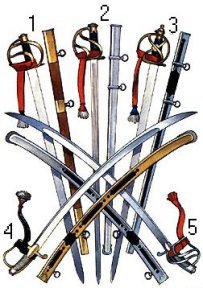 Picture:
1 - dragoon saber 1806,
2 - cuirassier saber 1810,
3 - cuirassier saber 1798,
4 - light cavalry saber 1798,
5 - light cavalry saber 1809
Picture:
1 - dragoon saber 1806,
2 - cuirassier saber 1810,
3 - cuirassier saber 1798,
4 - light cavalry saber 1798,
5 - light cavalry saber 1809
The basic weapon of cavalry was the saber.
During Napoleonic Wars the Russian cavalry used several patterns of curved and
straight sabers. The officers’ sabers were of better quality, most often their hilt was
gilded. Additionally the cavalry was issued some number of weapons of foreign origin:
British, Austrian, Prussian or (captured) French.
Unlike the use of the pistol or carbine the saber required the physical contact with the opponent.
The curved saber was used in its best when swung in an arc to achieve a cutting
effect by a motion towards the center of the enemy with the horseman’s arm extended.
It also allowed to cut with a slicing action, where the blade's edge
was drawn across the opponent with a quite good result. Straight saber may also cut, but this is directly dependent for its effect on
the weight of the blade and the position of its center of balance.
The cut was a more instinctive blow than a thrust, and in cavalry mêlées the average
cavalryman will tend to cut even if his sword is more suited to the thrust.
The light cavalry saber - Pattern 1798 was used by the hussar and ulan regiments, the dragoon regiments of the
Caucasian inspection till 1809, and until 1812 by Lifeguard Uhlan Regiment.
It had a curved, single-edged blade. Its length was about 87 cm, width of blade was 4,1 cm,
the blade curvature averaged 6,5/37 cm. The total length of this saber was approx. 100 cm. Its hilt comprised of a wooden grip,
which was covered in leather and protected by a guard. The guard was made of cross-guard with the knuckle bow and a double langet.
The weight of the saber with the wooden scabbard was 1,8 kg and 2,1 kg in the steel scabbard.
The light cavalry saber - Pattern 1809 replaced the old sabers in the Lifeguard Uhlan Regiment,
Lifeguard Hussar Regiment, and in the dragoon regiments of the Caucasian Inspection.
By 1812 this weapon replaced also the old sabers in all the hussar and ulan regiments.
The blade of 1809 saber was curved, single-edged, and featured one wide fuller.
The total length was 103 cm, the blade's length was about 88 cm, the blade's width was approx.
3 cm (3,6 cm), and the blade's curvature averaged 7/36.5 cm. The iron hilt with 3 hops
consisted of a wooden, covered in leather grip, and a guard that was made of three bars and a cross-guard piece. The steel scabbard was common although could be find also ones made of wood and having iron settings. The weight of the saber with the steel scabbard was about 1,9 kg.
The heavy cavalry saber - Pattern 1798 was carried by the cuirassiers at Austerlitz, Eylau and Friedland until 1809-1810
when it was replaced by a thinner weapon modeled on the popular French patterns.
This vicious old weapon had a straight blade 90-cm long, 4-cm wide and weighted 2.1-kg.
It was not a blade for fencing finesse but it was a rather good cutting machine.
After war in 1805 the Russians introduced cavalry saber - Pattern 1806 for their dragoons.
It had a straight 89-cm long blade, was 3.8-cm wide, and weighted 1.65 kg.
This weapon was copied after the sabers of French dragoons and had a point enabling the
man to thrust more effectively than with the curved saber or with the old heavy cavalry sabers.
However the length of the blade was insufficient to make the dragoons equal to their French counterparts in a line vs line combat. It also
didn’t have the curvature needed to match the French hussars’ sabers in individual combat.
Before 1806 the dragoons carried their saber from a frog instead of slings as did the
cuirassiers. But when they received the new sabers of 1806 Pattern the scabbard had rings
for suspension on slings.
The heavy cavalry saber - Pattern 1809 (1810) was one of the most obvious images of the Russian
cuirassiers, perhaps second to the black armor. The troopers in the front rank charged with wrist turned inward, their hands at eye level and
the point lower than hand. The troopers in the second rank attacked saber high.
It was THE weapon for the heavies as it had a straight 97-cm long blade
allowing the greatest reach when used its point. This wapon was modeled on French cuirassiers’ saber. The scabbard was made of iron.
In 1811 part of dragoons received from arsenals in Moscow and Kiev the so-called
“Imperial pallash. ” It was Austrian broadsword weapon.
(Bezotosnyi, Vasiliev, Gorshman, Parhayev, Smirnov - “Russkaia armiia 1812-1814” Vlados,
Moskva 2000, p 15)
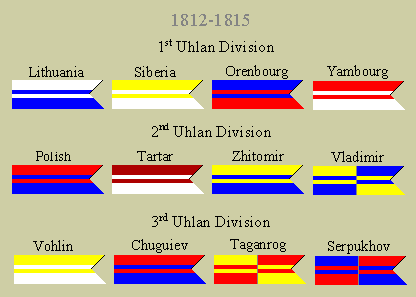 In 1801 was ordered that the privates in horse regiments (Polish and Tartar-Lithuanian)
had lances with woodwork painted in red. In May 1806 the privates of Grand Duke Constantine
Uhlan Regiment replaced their carbines with lances that had their woodwork painted in black.
The adopted in 1806-1807 by all regiments lance shaft was black.
According to Polish tradition, only the troopers in the first rank were armed with lances
and the Russians followed this pattern. The total length of the lance averaged between 280 and 290 cm.
In 1801 was ordered that the privates in horse regiments (Polish and Tartar-Lithuanian)
had lances with woodwork painted in red. In May 1806 the privates of Grand Duke Constantine
Uhlan Regiment replaced their carbines with lances that had their woodwork painted in black.
The adopted in 1806-1807 by all regiments lance shaft was black.
According to Polish tradition, only the troopers in the first rank were armed with lances
and the Russians followed this pattern. The total length of the lance averaged between 280 and 290 cm.
The pennant was called horonzhevka from Polish choragiewka.
 In 1812 selected troopers of ulan regiments were sent as instructors to
drill hussars with the use of the lance.
Between April and May most of the hussar regiments were armed with lances.
Three regiments campaigning on Crimean Peninsula and along Danube River were issued lances a
little bit later.
In 1812 selected troopers of ulan regiments were sent as instructors to
drill hussars with the use of the lance.
Between April and May most of the hussar regiments were armed with lances.
Three regiments campaigning on Crimean Peninsula and along Danube River were issued lances a
little bit later.
Officially the lances of hussars were without pennants.
Unofficially the Pavlograd and the Izum hussars attached pennants (turquoise-white
and red-dark blue, respectively) to their lances and probably at least the Ahtyrka
did the same. According to Kutuzov’s headquarters’ journal of military operations
(8 Oct. 1812): “Mjr. Hrapovitski, in order to confuse the enemy, has ordered his hussars to
put pennants on their lances…”
(M. I. Kutuzov. - “Sbornik dokumentov” Vol. 4, Part 2. Moscow, 1955, p 130)
In the following campaigns in 1813-1815 it was left up to hussars if they want to abandon
or keep their lances. This is interesting that the Lifeguard Hussar Regiment never carried
lances.
|

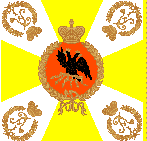


 Picture: French carabiniers versus Russian hussars in the battle of Borodino.
Picture by Keith Rocco, USA.
Picture: French carabiniers versus Russian hussars in the battle of Borodino.
Picture by Keith Rocco, USA.
 Unfortunately the uhlans didn’t stop there and said, OK, come out you bastards
and we will cut you to ribbons. The hotheaded uhlans rushed after Kellermann’s cavalry and got under
heavy canister and musket fire from infantry. The fire unsaddled many riders but quite amazingly others pushed forward and
managed to penetrate the French position. The uhlans got under fire from the
second line of infantry (2,000-3,000 muskets). This is said that some of the young uhlans that lost their
mounts were so angered that attacked the infantry on foot.
Baron Meller-Zakomelski rode in the head of the uhlans and was hit by a bullet.
He had trouble breathing and was surrounded by the French 5th Hussars.
Meller-Zakomelski was taken prisoner by trumpeter Pincemaille, who himself was
wounded. Hundreds of uhlans were hors de combat, and only approx. 200-250
of the toughest and luckiest rode back toward Bagration’s troops where Manteufel rallied them.
Unfortunately the uhlans didn’t stop there and said, OK, come out you bastards
and we will cut you to ribbons. The hotheaded uhlans rushed after Kellermann’s cavalry and got under
heavy canister and musket fire from infantry. The fire unsaddled many riders but quite amazingly others pushed forward and
managed to penetrate the French position. The uhlans got under fire from the
second line of infantry (2,000-3,000 muskets). This is said that some of the young uhlans that lost their
mounts were so angered that attacked the infantry on foot.
Baron Meller-Zakomelski rode in the head of the uhlans and was hit by a bullet.
He had trouble breathing and was surrounded by the French 5th Hussars.
Meller-Zakomelski was taken prisoner by trumpeter Pincemaille, who himself was
wounded. Hundreds of uhlans were hors de combat, and only approx. 200-250
of the toughest and luckiest rode back toward Bagration’s troops where Manteufel rallied them.
 The Russian cavalrymen had their actions 'on ice' too.
On March 6-9 1809 Yakov Kulniev was ordered to capture the Swedish Aland Islands (see map).
Kulniev’s force consisted of 200 Cossacks and 172 Grodno Hussars.
At 3 am the Russians appeared on the frozen sea. They could see the wheel
trails and footsteps of the Swedish troops on the snow that passed through
this area before. After long march they spotted on the skyline the rocks
of an island. As they advanced further the Swedish pickets fired upon them.
The Russian cavalrymen had their actions 'on ice' too.
On March 6-9 1809 Yakov Kulniev was ordered to capture the Swedish Aland Islands (see map).
Kulniev’s force consisted of 200 Cossacks and 172 Grodno Hussars.
At 3 am the Russians appeared on the frozen sea. They could see the wheel
trails and footsteps of the Swedish troops on the snow that passed through
this area before. After long march they spotted on the skyline the rocks
of an island. As they advanced further the Swedish pickets fired upon them.
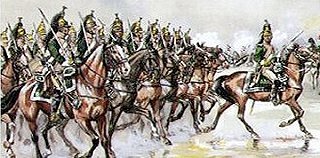
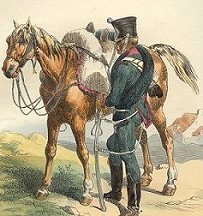

 General Nansouty (see picture ->) ordered Generals Colbert, Guyot, and Pire to charge with
the cavalry of the Imperial Guard. Horse batteries of Old Guard supported them.
The French guardsmen broke the hussars and pursued in their turn.
Vasilchikov sent in the 3rd Dragoon Division.
The dragoons formed “in two lines” attacked Nansouty’s Guard Cavalry frontallly and from
the flank. The enemy was broken and pursued beyond La Rothiere itself leaving behind
General Nansouty (see picture ->) ordered Generals Colbert, Guyot, and Pire to charge with
the cavalry of the Imperial Guard. Horse batteries of Old Guard supported them.
The French guardsmen broke the hussars and pursued in their turn.
Vasilchikov sent in the 3rd Dragoon Division.
The dragoons formed “in two lines” attacked Nansouty’s Guard Cavalry frontallly and from
the flank. The enemy was broken and pursued beyond La Rothiere itself leaving behind
 Inspector of Cavalry Grand Duke Constantine (1779-1831).
Inspector of Cavalry Grand Duke Constantine (1779-1831). General of Cavalry Ferdinand Wintzingerode (1761-1818).
General of Cavalry Ferdinand Wintzingerode (1761-1818). General of Cavalry Fedor Uvarov (1773-1824).
General of Cavalry Fedor Uvarov (1773-1824). General of Cavalry Prince Dmitrii Golitzin (1771-1844).
General of Cavalry Prince Dmitrii Golitzin (1771-1844). General-Lieutenant Fedor Korf (1774-1823).
General-Lieutenant Fedor Korf (1774-1823). General-Lieutenant Illarion Vasilchikov (1775-1847).
General-Lieutenant Illarion Vasilchikov (1775-1847). General-Lieutenant Karl Lambert (1772-1843.
General-Lieutenant Karl Lambert (1772-1843. General-Lieutenant Efim Chaplitz (1768-1825).
General-Lieutenant Efim Chaplitz (1768-1825). General-Major Ivan Dorohov (1762-1815).
General-Major Ivan Dorohov (1762-1815). General-Major Yakov Kulnev (1763-1812).
General-Major Yakov Kulnev (1763-1812). The cuirassier and dragoon regiments carried standards.
The cuirassier and dragoon regiments carried standards.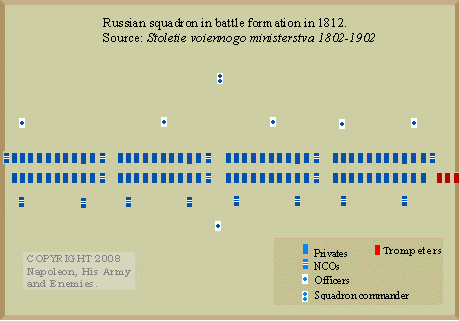
 Picture: Battle of Fere Champenoise, France 1814.
Russian cuirassiers routed French infantry formed in squares.
Picture by Oleg Parkhaiev, Russia.
Picture: Battle of Fere Champenoise, France 1814.
Russian cuirassiers routed French infantry formed in squares.
Picture by Oleg Parkhaiev, Russia.
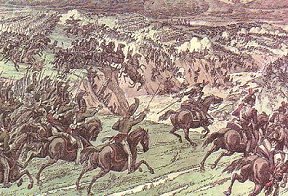 Picture: Battle of Katzbach 1813.
Russian dragoons defeated and pursued French cavalry.
Picture by Oleg Parkhaiev.
Picture: Battle of Katzbach 1813.
Russian dragoons defeated and pursued French cavalry.
Picture by Oleg Parkhaiev.
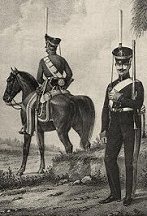 Picture: Livland (Livonia) Horse Jagers in 1812-1814, by Viskovatov.
Picture: Livland (Livonia) Horse Jagers in 1812-1814, by Viskovatov.
 Picture: private and staff officer of Volhin Uhlan Regiment 1808-1811,
by Viskovatov.
Picture: private and staff officer of Volhin Uhlan Regiment 1808-1811,
by Viskovatov.
 Picture: Battle of Kliastitzy 1812, Russia.
Picture: Battle of Kliastitzy 1812, Russia. The flamboyant, hard drinking and dashing hussars enjoyed a great popularity
in Russia. There were poems, books and stories written about them. In 1815 Alexander
The flamboyant, hard drinking and dashing hussars enjoyed a great popularity
in Russia. There were poems, books and stories written about them. In 1815 Alexander
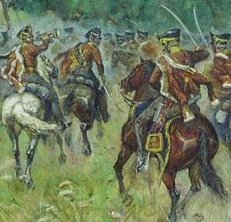 The army cheered the hussars on numerous occasions. They were outstanding fighters,
equal to the Prussian, British and French hussars and probably also to the famous Austrian
hussars (at least between 1806 and 1814).
The army cheered the hussars on numerous occasions. They were outstanding fighters,
equal to the Prussian, British and French hussars and probably also to the famous Austrian
hussars (at least between 1806 and 1814).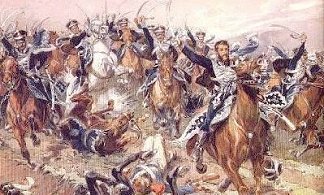 @ - On May 25th 1807 Yakov Kulniev with two squadrons
of Grodno Hussars observed the French across Pasleka River before sending Rudiger
with one squadron. The French had no time to form a square and fled losing 100 men
as prisoners. Near the village of Kommersdorf, Kulniev’s hussars spotted an enemy
camp. To their dissapointment it was full of wounded and sick French soldiers.
The poor fellows were shocked seeing the Russians in the midst of their camp.
The Grodno Hussars continued their raid and captured an artillery convoy with
cannons, mortars and 40 wagons full of gunpowder, cannonballs and grenades.
The escort of this convoy gave no problems for the hussars, except five dragoons
who galloped away. Kulniev send after them NCO Gasenko with three hussars.
After a short fight two dragoons were laid on the ground and three were taken as
prisoners.
@ - On May 25th 1807 Yakov Kulniev with two squadrons
of Grodno Hussars observed the French across Pasleka River before sending Rudiger
with one squadron. The French had no time to form a square and fled losing 100 men
as prisoners. Near the village of Kommersdorf, Kulniev’s hussars spotted an enemy
camp. To their dissapointment it was full of wounded and sick French soldiers.
The poor fellows were shocked seeing the Russians in the midst of their camp.
The Grodno Hussars continued their raid and captured an artillery convoy with
cannons, mortars and 40 wagons full of gunpowder, cannonballs and grenades.
The escort of this convoy gave no problems for the hussars, except five dragoons
who galloped away. Kulniev send after them NCO Gasenko with three hussars.
After a short fight two dragoons were laid on the ground and three were taken as
prisoners.  @ - In 1813 north of Leipzig, the French infantry was
retreating from Eutritzsch when General Blücher (see picture ->) expressed a wish to attack them.
General Vasilchikov heard his words and responded “If your Excellency will permit,
I will try with my hussars.” Permission was given and Vasilchikov issued orders.
The 2nd Hussar Division (Ahtirka, Alexandria, Marioupol, and White Russia Hussars) led by
Lanskoi swept proudly past, and then charged the infantry.
The hussars then noticed several hussar, chasseur and dragoon regiments, which belonged to the III Cavalry
Corps under General Arrighi. Two hussar regiments struck the right flank of Arrighi’s
cavalry. As the Prussian witness, Graf Henkel von Donnersmark wrote,
they “went on at a cracking pace”. The French chasseurs and hussars fled,
some galloped toward Leipzig itself, while others sought refuge on the other
bank of the Parthe River. There they continued toward the positions occupied
by the infantry and artillery of the VII Corps. The pursuit was long,
reaching Leipzig itself. The hussars captured a half thousand prisoners and 5 guns.
Von Donnersmark remarked that this attack was “one of the best that I ever saw
Russian cavalry made.” The defeat of Arrighi’s cavalry shook morally the infantry
on the other side of the river. The hussars suffered very light casualties up to
this point but when they were returning from the long pursuit they got under fire
from the French infantry.
@ - In 1813 north of Leipzig, the French infantry was
retreating from Eutritzsch when General Blücher (see picture ->) expressed a wish to attack them.
General Vasilchikov heard his words and responded “If your Excellency will permit,
I will try with my hussars.” Permission was given and Vasilchikov issued orders.
The 2nd Hussar Division (Ahtirka, Alexandria, Marioupol, and White Russia Hussars) led by
Lanskoi swept proudly past, and then charged the infantry.
The hussars then noticed several hussar, chasseur and dragoon regiments, which belonged to the III Cavalry
Corps under General Arrighi. Two hussar regiments struck the right flank of Arrighi’s
cavalry. As the Prussian witness, Graf Henkel von Donnersmark wrote,
they “went on at a cracking pace”. The French chasseurs and hussars fled,
some galloped toward Leipzig itself, while others sought refuge on the other
bank of the Parthe River. There they continued toward the positions occupied
by the infantry and artillery of the VII Corps. The pursuit was long,
reaching Leipzig itself. The hussars captured a half thousand prisoners and 5 guns.
Von Donnersmark remarked that this attack was “one of the best that I ever saw
Russian cavalry made.” The defeat of Arrighi’s cavalry shook morally the infantry
on the other side of the river. The hussars suffered very light casualties up to
this point but when they were returning from the long pursuit they got under fire
from the French infantry.
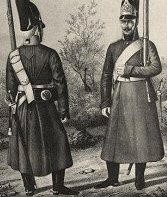 In 1802 was ordered that the cavalry greatcoat should be of infantry design with small alterations,
for example instead of having 7 it had to have 6 buttons.
The greatcoat was made of gray-brown rough cloth for troopers and silver-gray
for the officers. In 1808 was ordered that the greatcoat would have the collar and shoulder
straps in regimental color. In some regiments the collars bore patches in regimental color.
In 1802 was ordered that the cavalry greatcoat should be of infantry design with small alterations,
for example instead of having 7 it had to have 6 buttons.
The greatcoat was made of gray-brown rough cloth for troopers and silver-gray
for the officers. In 1808 was ordered that the greatcoat would have the collar and shoulder
straps in regimental color. In some regiments the collars bore patches in regimental color.
 The cuirassiers wore greatcoat underneath of the armor, which was then visible to
the enemy and communicated that they are not merely the armor-deprived dragoons.
It was however possible to wear the greatcoat over the armor. In such case it was thrown
over the left shoulder like did the hussars with their pelisses (in the right hand was
the saber or pistol).
The cuirassiers wore greatcoat underneath of the armor, which was then visible to
the enemy and communicated that they are not merely the armor-deprived dragoons.
It was however possible to wear the greatcoat over the armor. In such case it was thrown
over the left shoulder like did the hussars with their pelisses (in the right hand was
the saber or pistol).

 The coat was called - from Prussian - the kollet, and was white for cuirassiers and green for dragoons. It was short tailed and double-breasted
jacket with 2 rows of buttons. On May 20th 1814 (JC) was ordered that the kolet has to be single breasted,
of one row of buttons.
The coat was called - from Prussian - the kollet, and was white for cuirassiers and green for dragoons. It was short tailed and double-breasted
jacket with 2 rows of buttons. On May 20th 1814 (JC) was ordered that the kolet has to be single breasted,
of one row of buttons. Uhlan's coat however had lapels, see picture -->
Uhlan's coat however had lapels, see picture -->
 The trumpets were brass. The shevrons on cuirassier trumpeters’ sleeves were white with
facing color threads - two lines along both edges and a diamond shape in the centre.
The trumpeters of Military Order Cuirassier Regiment had their shevrons in orange with 3 black lines.
(Cuirassier regiments used kettledrums until December 1811.
After that year they were discontinued and only the guard cuirassiers kept them shortly.)
All trupmets in cuirassier and dragoon regiments had red (not black)
horse hair crest on helmets.
The trumpets were brass. The shevrons on cuirassier trumpeters’ sleeves were white with
facing color threads - two lines along both edges and a diamond shape in the centre.
The trumpeters of Military Order Cuirassier Regiment had their shevrons in orange with 3 black lines.
(Cuirassier regiments used kettledrums until December 1811.
After that year they were discontinued and only the guard cuirassiers kept them shortly.)
All trupmets in cuirassier and dragoon regiments had red (not black)
horse hair crest on helmets.
 The shevrons on dragoon and jager trumpeters’ sleeves were white.
The shevrons on dragoon and jager trumpeters’ sleeves were white.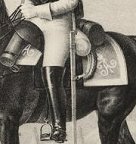 In cuirassier regiments the shabraque (color cloth put over saddle) was called cheprak
and was worn under the saddle.
Cuirassiers' shabraques were in regimental colors. For example His Majesty Cuirassier
Regiment had light blue shabraques with white “guard” lace and with a sky blue stripe.
The Lifeguard Horse Regiment had a dark blue shabraque edged with two gold laces; the
Guard Cavalry Regiment (Chevaliers Garde, Kavallergarde) had a red shabraque edged with two golden laces.
Until 1809 the corners of the shabraque of army cuirassiers were round
(according to Zvegintsov, Kosmolinski in “Sovietskiie muzei - Ot Austerlitza do Tilzitza” and others)
and then replaced by squared ones for the NCOs and privates. Other sources don’t confirm
it and the squared corners are given for the entire period of Napoleonic Wars.
In its rear corners and on the holster caps was a crowned imperial cypher “A” over “I” in yellow or white.
These cyphers stood for Alexandr and Imperator (Emperor). The exception were His Majesty
Cuirassier Regiment and Her Majesty Cuirassier Regiment, which bore St. George star.
The shabraques of Guard Cavalry Regiment and Lifeguard Horse Regiment bore St. Andrew 8-corner
star with 2-head eagle in the center of it.
In cuirassier regiments the shabraque (color cloth put over saddle) was called cheprak
and was worn under the saddle.
Cuirassiers' shabraques were in regimental colors. For example His Majesty Cuirassier
Regiment had light blue shabraques with white “guard” lace and with a sky blue stripe.
The Lifeguard Horse Regiment had a dark blue shabraque edged with two gold laces; the
Guard Cavalry Regiment (Chevaliers Garde, Kavallergarde) had a red shabraque edged with two golden laces.
Until 1809 the corners of the shabraque of army cuirassiers were round
(according to Zvegintsov, Kosmolinski in “Sovietskiie muzei - Ot Austerlitza do Tilzitza” and others)
and then replaced by squared ones for the NCOs and privates. Other sources don’t confirm
it and the squared corners are given for the entire period of Napoleonic Wars.
In its rear corners and on the holster caps was a crowned imperial cypher “A” over “I” in yellow or white.
These cyphers stood for Alexandr and Imperator (Emperor). The exception were His Majesty
Cuirassier Regiment and Her Majesty Cuirassier Regiment, which bore St. George star.
The shabraques of Guard Cavalry Regiment and Lifeguard Horse Regiment bore St. Andrew 8-corner
star with 2-head eagle in the center of it.
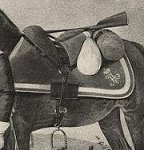
 The shabraque in dragoon, hussar and uhlan regiments were
worn over the saddle and were called valtrap. The shabraque was edged with white or
yellow lace. In 1808 the old valtrap was replaced by a dark green for all dragoon
regiments with edging and cyphers in the rear corners in regimental color.
The length and width, in the back, of the valtrap was 111 cm. The shabraque of Lifeguard Dragoon Regiment
was edged with 2 yellow laces.
The shabraque in dragoon, hussar and uhlan regiments were
worn over the saddle and were called valtrap. The shabraque was edged with white or
yellow lace. In 1808 the old valtrap was replaced by a dark green for all dragoon
regiments with edging and cyphers in the rear corners in regimental color.
The length and width, in the back, of the valtrap was 111 cm. The shabraque of Lifeguard Dragoon Regiment
was edged with 2 yellow laces.
 Uniform of Russian cuirassier in 1805, 1806, 1807 Campaigns:
helmet, no cuirass, white coat, the collar was cut back to expose a black stock worn around the throat.
Uniform of Russian cuirassier in 1805, 1806, 1807 Campaigns:
helmet, no cuirass, white coat, the collar was cut back to expose a black stock worn around the throat.
 Originally the dragoons' coat was light green. On November 7 1807 (JC) was ordered that the
coats has to be dark green, with red turnbacks. In fact they were almost blackish, especially
in the beginning of campaign before the sun and
rain faded the dye.
Originally the dragoons' coat was light green. On November 7 1807 (JC) was ordered that the
coats has to be dark green, with red turnbacks. In fact they were almost blackish, especially
in the beginning of campaign before the sun and
rain faded the dye.
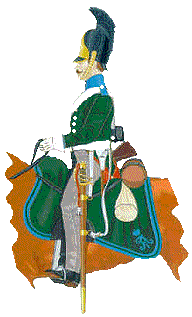

 The hussar wore two coats, dolman and pelisse (mentik). Both coats
often had red-brown leather patches sewn on the elbows as reinforcements.
The pelisse had 3 rows of buttons, numerous braids and lambskin edging.
From April through September, it was worn thrown back over the left shoulder
(in the right hand was the saber). Between September and March it was worn with
the arms in the sleeves as protection from cold.
The hussar wore two coats, dolman and pelisse (mentik). Both coats
often had red-brown leather patches sewn on the elbows as reinforcements.
The pelisse had 3 rows of buttons, numerous braids and lambskin edging.
From April through September, it was worn thrown back over the left shoulder
(in the right hand was the saber). Between September and March it was worn with
the arms in the sleeves as protection from cold.
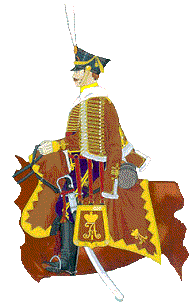

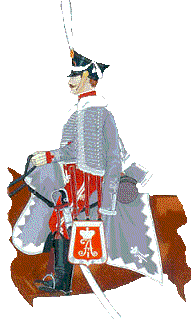
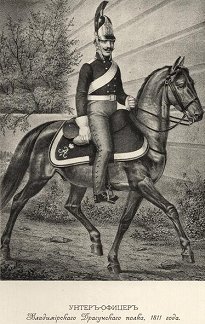 The history of cavalry horse in Russia is an interesting story.
It was under Tsar Peter the Great that several new state-owned studs were
organized to produce mounts for the army. Most of these horses had European and not
Tatar origins.
The history of cavalry horse in Russia is an interesting story.
It was under Tsar Peter the Great that several new state-owned studs were
organized to produce mounts for the army. Most of these horses had European and not
Tatar origins.
 Picture: 1 - cavalry rifle 1803, 2 - hussar musketoon,
3 - pistols
Picture: 1 - cavalry rifle 1803, 2 - hussar musketoon,
3 - pistols
 Picture:
1 - dragoon saber 1806,
2 - cuirassier saber 1810,
3 - cuirassier saber 1798,
4 - light cavalry saber 1798,
5 - light cavalry saber 1809
Picture:
1 - dragoon saber 1806,
2 - cuirassier saber 1810,
3 - cuirassier saber 1798,
4 - light cavalry saber 1798,
5 - light cavalry saber 1809
 In 1801 was ordered that the privates in horse regiments (Polish and Tartar-Lithuanian)
had lances with woodwork painted in red. In May 1806 the privates of Grand Duke Constantine
Uhlan Regiment replaced their carbines with lances that had their woodwork painted in black.
The adopted in 1806-1807 by all regiments lance shaft was black.
According to Polish tradition, only the troopers in the first rank were armed with lances
and the Russians followed this pattern. The total length of the lance averaged between 280 and 290 cm.
In 1801 was ordered that the privates in horse regiments (Polish and Tartar-Lithuanian)
had lances with woodwork painted in red. In May 1806 the privates of Grand Duke Constantine
Uhlan Regiment replaced their carbines with lances that had their woodwork painted in black.
The adopted in 1806-1807 by all regiments lance shaft was black.
According to Polish tradition, only the troopers in the first rank were armed with lances
and the Russians followed this pattern. The total length of the lance averaged between 280 and 290 cm.
 In 1812 selected troopers of ulan regiments were sent as instructors to
drill hussars with the use of the lance.
Between April and May most of the hussar regiments were armed with lances.
Three regiments campaigning on Crimean Peninsula and along Danube River were issued lances a
little bit later.
In 1812 selected troopers of ulan regiments were sent as instructors to
drill hussars with the use of the lance.
Between April and May most of the hussar regiments were armed with lances.
Three regiments campaigning on Crimean Peninsula and along Danube River were issued lances a
little bit later.
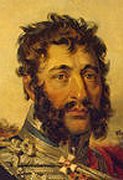 The new recruits had their heads and beards shaven. Some of them tried in vain to bribe
the barbers. The cavalrymen and Cossacks, privates and officers, all wore mustaches.
(The only few exceptions were officers of dragoon and cuirassier regiments.)
The new recruits had their heads and beards shaven. Some of them tried in vain to bribe
the barbers. The cavalrymen and Cossacks, privates and officers, all wore mustaches.
(The only few exceptions were officers of dragoon and cuirassier regiments.)

 On July 18-19th 1812 at Druia the
hussars and Cossacks defeated French 11th and 12th Chasseurs and Polish 10th Hussars.
In the end of July, within the period of several days Tzytliatzev with 20 hussars captured 200 prisoners. On Oct. 6-7th (18-19th)
they fought with distinction at the Second Battle of Polotzk.
In April 1813 the Grodno hussars were awarded with silver trumpets for 1812 war.
On July 18-19th 1812 at Druia the
hussars and Cossacks defeated French 11th and 12th Chasseurs and Polish 10th Hussars.
In the end of July, within the period of several days Tzytliatzev with 20 hussars captured 200 prisoners. On Oct. 6-7th (18-19th)
they fought with distinction at the Second Battle of Polotzk.
In April 1813 the Grodno hussars were awarded with silver trumpets for 1812 war.
